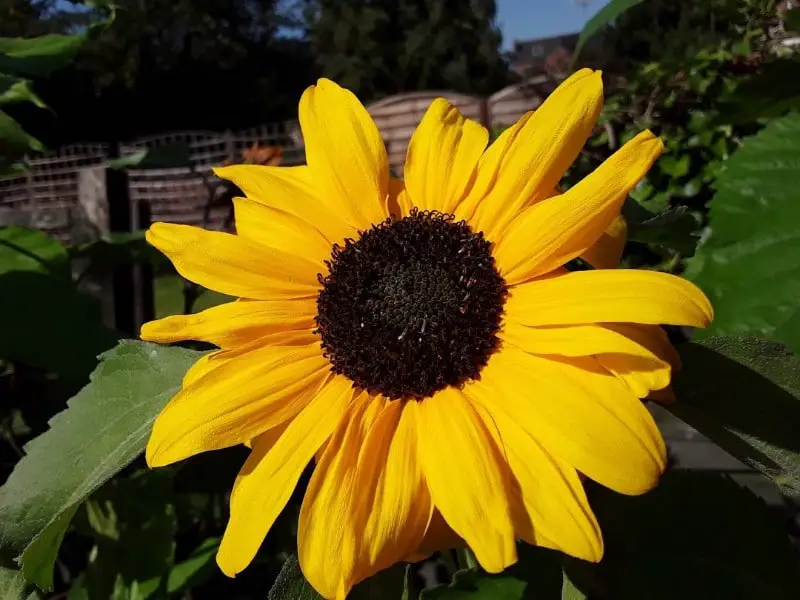Sunflowers have been living among us for thousands of years, but why are sunflowers called sunflowers? I’ve been asked this question many times so, in this article, I’ll be providing the answer.
Maybe it’s because they look like the sun. Perhaps the science of the Sunflower following the sun holds the key. Or Could the answer lay in an ancient Greek myth?
So, why is a Sunflower called a Sunflower? The word Sunflower is from the Greek word Helianthus, Heli means sun, Anthus means flower. Sunflowers turn towards the sun and look like the sun. Ancient cultures worshiped them, and mythical stories called them Sunflowers. Perhaps it is all of these reasons, and more. Let us find out.
I adore sunflowers, and the fascination behind their name would lead me down a garden path of wonder, a path that I’d love to share with you.

So, I went on my journey and found four good reasons as to why I think sunflowers are called sunflowers, these reasons are;
- The literal meaning of the word Sunflower
- A mythical story of the Sunflowers
- The science of Sunflowers following the sun
- A cultural history off sunflowers
Let’s get started with…
1. The literal meaning of the word Sunflower
Most species of plants have a scientific and botanical name, and usually, this name is derived from ancient Greek and Latin languages. Sunflowers are no different.

Helianthus is the Greek word for Sunflower. If we split this word up we get Helios, which means Sun, and anthios which means flower.
Could it be that simple? That they thought it just looked like the sun? Or was it because of the ancient Greek myth about the sun God Apollo and his unrequited love for Clytie, a Greek water nymph?
which lead me onto…
2. A mythical story of the Sunflower
There are many versions of this unrequited love story. it’s a heartfelt tale, and I’ve taken great care to write about it in detail, in my article The Meaning of Sunflowers.
But for now, here’s the love story In brief.
Clytie was in love with Apollo, the Sun God. Every day her gaze followed him as he rode his chariot across the sky pushing the sun from east to west.
She gazed at him longingly in the hope he would return her attention and her love.
Unfortunately, Apollo was in love with someone else. This left Clytie lovesick, and she became so depressed she wouldn’t eat or drink.
With each passing day, she grew forlorn as she just wearily stared at the Sun God moving across the sky.
The other Gods felt sorry for Clytie. They could see she was distressed and withering away, and they felt so sorry for her.
So the Gods took it upon themselves to transform her into a glorious Sunflower, this they hoped, would help heal her pain.
And as a Sunflower, Clytie still follows the sun across the sky every day.
So, this may be the reason why they are named sunflowers, in honor of a sad love story.
This leads us to Sunflowers following the sun and how scientifically they do this, which may be another reason as to why they may be called Sunflowers.
3. The science of Sunflowers following the sun.
The scientific name for flowers following the path of the sun is Heliotropism. This word is also from the ancient Greek language. And if we split this word up we get Helio, which means Sun, and tropism, which means to turn.

I’ve gone into more details and the science of how and why this amazing phenomenon happens, and why it benefits nature, here in my article ‘Why Do Sunflowers Follow the Sun’.
But for now, here’s the science in short.
Certainly, the sunflower is one of many flower species that follow the sun across the sky, and once fully bloomed the flower head usually stays where it has blossomed, especially if it’s a large and weighty bloom.
The reason why a sunflower’s young bud and bloom follow the sun is to gain as much energy from the sun as it can to grow big and strong. And when the bud has blossomed the sun warms the pollen to entice bees, butterflies, and other small beasties to pollinate it.
Pollination is the main goal of sunflowers, pollination produces seeds. Thousands of years ago sunflower seeds were one of the main food sources for South Americans.
Sunflowers seeds are still one of the biggest crops grown and sold worldwide.
Because sunflowers were the main food source they were regarded very highly. This brings us nicely onto sunflowers being given as offerings in ancient ceremonies.
4. Cultural history of Sunflowers
As I mentioned above, the sunflower has been a main food source for South Americans for thousands of years.

During this time, sunflowers were also thought to worship the sun by following it throughout the day.
This was regarded as devotion, and loyalty to the sun, and very spiritual too, just like a follower of faith.
With this devotion, the sunflower was thought to be the bringer of life by means of producing an abundance of food in the form of seeds.
Sunflower seeds are used in many food dishes and have properties for healing purposes too.
There are archeological finds in south America that depict the sun in places of worship. The Priests and Priestesses would adorn themselves with sunflowers, and enter the Temples.
The sunflowers were picked, prepared, and given as offerings in good faith to the sun, and thanks for a good harvest, with the hope of an abundant crop in the future.
The sun and sunflowers seemed to be linked together as a bringer of good fortune and health.
My final thoughts
So, there we have it, four reasons that could be the answer to why sunflowers are called sunflowers.
The Greeks gave us a literal name for them, and a wonderful story to ponder over.
Science furthered the fact that sunflowers do indeed follow the sun, to earn their name Sunflower.
And historical evidence has found that the sunflower was part of cultural faith involving the sun, and Sunflowers being given as an offering.
I like all of these reasons, fact, and mythological. And maybe they all hold some truth to the reason why Sunflowers are Called Sunflowers.
One fact I’m sure about is this… if Sunflowers were known by any other name, they would still put a smile on my face every day.
I hope you enjoyed this article. And if you can think of other reasons why sunflowers are called sunflowers I’d love to hear from you. Thank you 🙂
Here are more articles that might interest you too.

